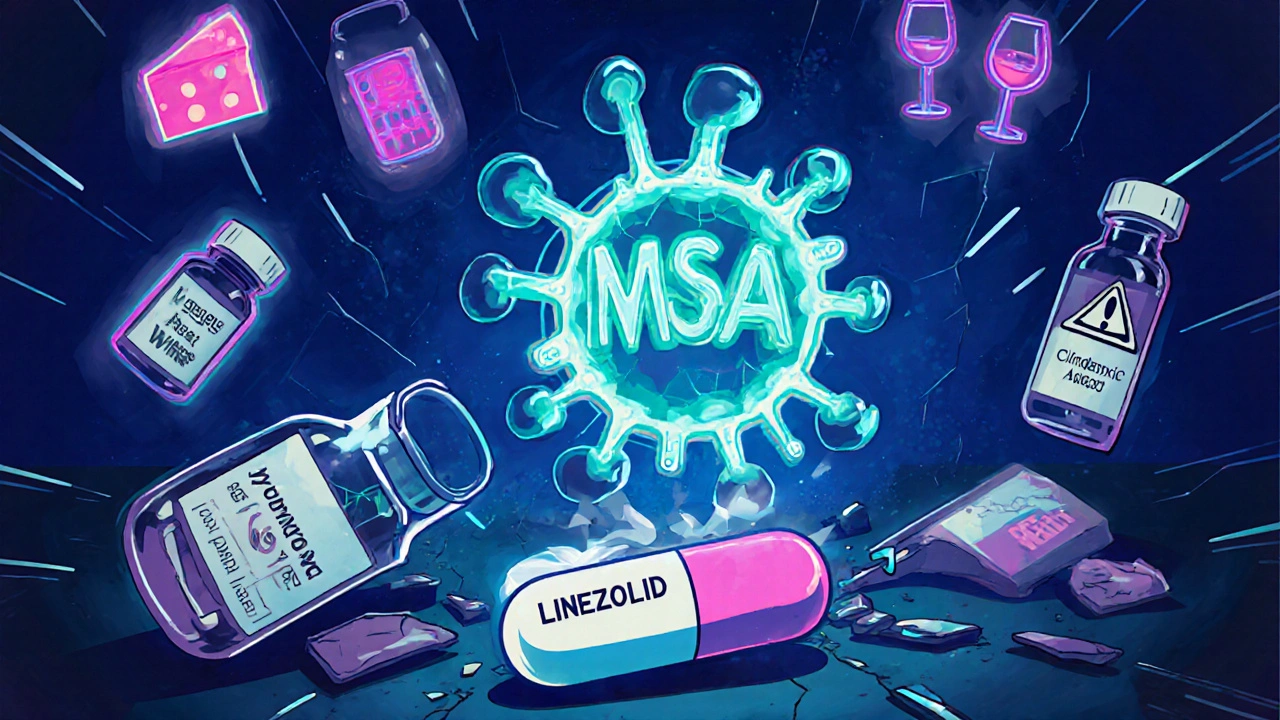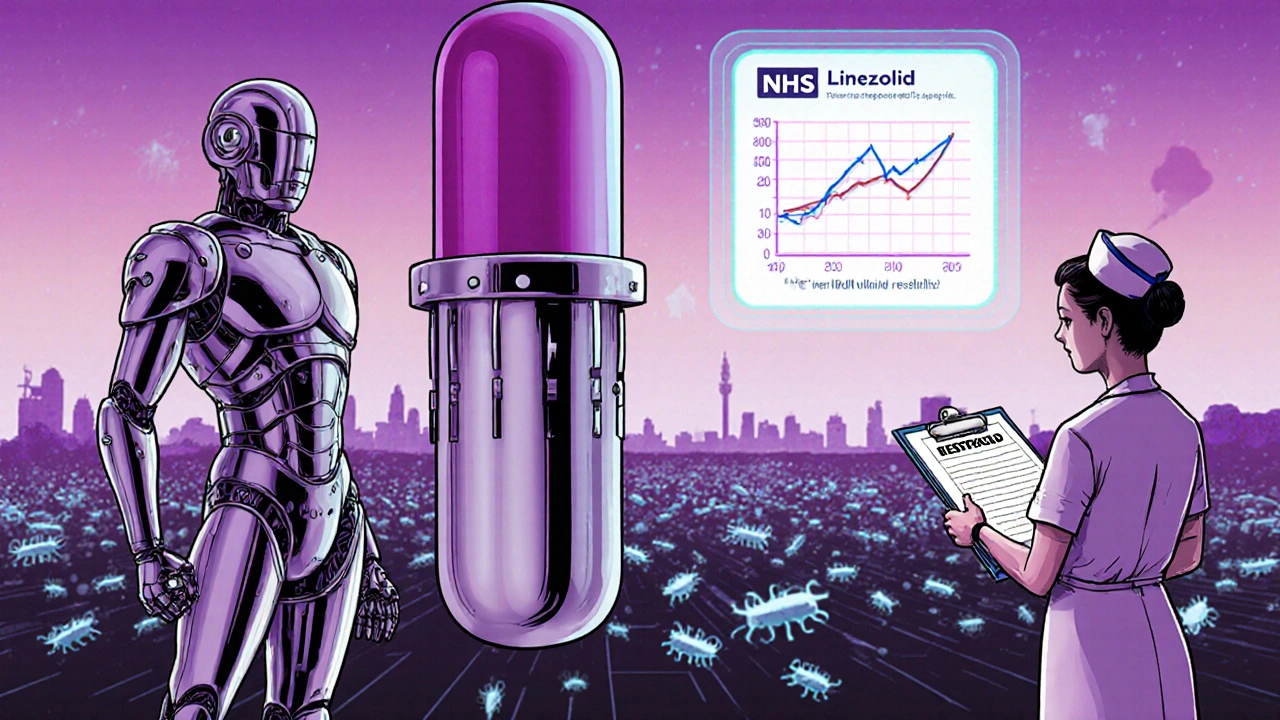Zyvox (Linezolid) vs. Alternatives: What Works Best for Antibiotic-Resistant Infections
 Oct, 30 2025
Oct, 30 2025
Antibiotic Treatment Selector for Resistant Infections
Find Your Best Antibiotic Option
This tool helps you understand which antibiotic might be most appropriate for your specific situation. Select your infection type and key factors to see recommendations based on the latest medical guidelines.
Key Considerations
Important: This tool is for informational purposes only. Always consult with your healthcare provider for medical advice and treatment decisions.
How this works
Based on your selections, this tool will show the most appropriate antibiotics for your situation, highlighting key advantages and considerations.
How to use
Select your options above to get personalized recommendations. The tool considers factors like infection location, medical history, and cost.
When you’re fighting a serious bacterial infection like MRSA or VRE, time matters. If standard antibiotics have failed, your doctor might turn to Zyvox (linezolid). But it’s not the only option. And it’s not always the best one. Knowing how linezolid stacks up against other antibiotics can help you understand your treatment plan - and ask the right questions.
What Zyvox (Linezolid) Actually Does
Zyvox is the brand name for linezolid, an antibiotic that works differently from most others. While penicillin or vancomycin attack the bacterial cell wall, linezolid stops bacteria from making proteins. Without proteins, bacteria can’t grow or multiply. This makes it useful against tough infections like:
- MRSA (methicillin-resistant Staphylococcus aureus)
- VRE (vancomycin-resistant Enterococcus)
- Some types of hospital-acquired pneumonia
- Skin infections that won’t respond to other drugs
One big advantage? Linezolid works both as an IV drip and as a pill. That means you can often switch from hospital treatment to oral pills at home - no more daily IVs. It’s a game-changer for recovery.
Vancomycin: The Old Standard
For years, vancomycin was the go-to drug for MRSA. It’s been around since the 1950s and is still widely used. But here’s the catch: vancomycin only works as an IV. You can’t take it by mouth for systemic infections. That means longer hospital stays, more IV lines, and more risk of infection at the injection site.
Vancomycin also needs regular blood tests to check kidney function and drug levels. Too little? The infection might come back. Too much? You risk kidney damage or hearing loss. Linezolid doesn’t require those tests, making it simpler to manage.
But vancomycin is cheaper. A full course of vancomycin might cost under £200 in the UK NHS system. Linezolid? Around £800-£1,200 for the same duration. Cost matters - especially when you’re treating a chronic or recurring infection.
Tedizolid: The Newer, Smarter Option
Tedizolid (brand name Sivextro) is essentially linezolid’s upgraded cousin. It works the same way - blocking protein production - but it’s more potent. You only need one 200mg tablet a day for six days. Linezolid? You take 600mg twice a day for up to 28 days.
Studies show tedizolid works just as well as linezolid for skin infections, but with fewer side effects. Nausea, headaches, and low platelets (a common issue with linezolid) happen less often with tedizolid. It’s also active against some linezolid-resistant strains, which is a growing concern.
The downside? Tedizolid is newer and more expensive. It’s not yet available on the NHS as a first-line option. Most patients get it only if linezolid fails or causes side effects. But if you’re paying privately or have good insurance, it’s worth asking about.
Daptomycin: For When You Need Something Stronger
If your infection has spread into the bloodstream or heart valves (bacteremia or endocarditis), daptomycin might be the better pick. It’s an IV-only drug that punches holes in bacterial membranes. It’s especially effective against MRSA in the blood.
Unlike linezolid, daptomycin doesn’t work for lung infections. It gets inactivated by lung surfactant - so it’s useless for pneumonia. Linezolid, on the other hand, penetrates lung tissue well.
Daptomycin also has a rare but serious side effect: muscle damage. Your doctor will check your CPK levels regularly. Linezolid doesn’t cause this. But daptomycin doesn’t cause bone marrow suppression like linezolid can. So it’s a trade-off.

Clindamycin: The Oral Alternative
For less severe skin or soft tissue infections, clindamycin is often the first oral antibiotic tried. It’s cheap, effective against many staph strains, and taken three times a day. It’s not as broad as linezolid, but for simple MRSA boils or abscesses, it’s often enough.
Here’s the problem: up to 30% of MRSA strains are resistant to clindamycin. Your doctor should test for this before prescribing it. If resistance is present, clindamycin won’t work - and you’ll waste weeks.
Clindamycin also carries a risk of C. difficile infection - a nasty, sometimes deadly diarrhea that can follow antibiotic use. Linezolid has a much lower risk of this. If you’ve had C. diff before, linezolid is safer.
When Linezolid Isn’t the Right Choice
Linezolid isn’t magic. It has real limits:
- Long-term use risks: Taking linezolid for more than two weeks can lower your platelet count, red blood cells, or nerve function. Some patients develop numbness or tingling in hands and feet.
- Diet restrictions: Linezolid interacts with tyramine - found in aged cheeses, cured meats, soy sauce, and red wine. Eating these while on linezolid can spike your blood pressure dangerously. You need to avoid them.
- Drug interactions: It can’t be mixed with SSRIs, SNRIs, or certain migraine meds. Mixing them can cause serotonin syndrome - a life-threatening condition with high fever, confusion, and muscle rigidity.
- Cost and access: In the UK, NHS guidelines often restrict linezolid to second-line use. You need a specialist’s approval to get it.
If you’re on linezolid for more than 14 days, your doctor should check your blood counts weekly. If your platelets drop below 100,000, they’ll stop the drug. It’s not optional - it’s a safety rule.
Which Alternative Should You Choose?
There’s no single best drug. The right choice depends on:
- Where the infection is: Skin? Linezolid or clindamycin. Blood? Daptomycin. Lungs? Linezolid.
- How long you’ve been sick: New infection? Try clindamycin or vancomycin. Recurring? Linezolid or tedizolid.
- Your medical history: Had C. diff? Avoid clindamycin. On antidepressants? Skip linezolid. Kidney problems? Avoid vancomycin.
- Cost and access: If you’re on the NHS, vancomycin is likely first. If you can afford it, tedizolid might be better.
Here’s a quick decision guide:
| Antibiotic | Form | Best For | Key Risk | Cost (NHS Estimate) |
|---|---|---|---|---|
| Linezolid (Zyvox) | IV or oral | MRSA, VRE, pneumonia, skin | Bone marrow suppression, serotonin syndrome | £800-£1,200 |
| Vancomycin | IV only | MRSA, bloodstream infections | Kidney damage, hearing loss | £150-£200 |
| Tedizolid (Sivextro) | Oral only | MRSA skin infections | Mild nausea | £1,500+ |
| Daptomycin | IV only | Bloodstream infections | Muscle damage | £1,000-£1,400 |
| Clindamycin | Oral or IV | Mild MRSA skin infections | C. difficile diarrhea | £20-£50 |
What Patients Should Ask Their Doctor
If you’re prescribed linezolid or any of these alternatives, don’t just take the script. Ask:
- Why this drug and not another?
- Is there a cheaper option that would work just as well?
- Do I need blood tests? How often?
- What foods or medicines should I avoid?
- What happens if this doesn’t work?
Many patients assume antibiotics are interchangeable. They’re not. Each has a unique profile - and the right one depends on your body, your infection, and your life.
Final Thought: It’s Not About the Drug - It’s About the Fit
Zyvox saved lives when vancomycin stopped working. But it’s not the hero everyone thinks it is. It’s a tool - powerful, but with limits. The same goes for tedizolid, daptomycin, or even clindamycin.
The goal isn’t to find the "strongest" antibiotic. It’s to find the one that fits your infection, your health, and your lifestyle. That’s the real science behind the prescription.
Can I take Zyvox if I’m on antidepressants?
No. Zyvox (linezolid) can cause a dangerous interaction with SSRIs, SNRIs, and other antidepressants. This can lead to serotonin syndrome - a life-threatening condition with symptoms like high fever, rapid heartbeat, confusion, and muscle stiffness. If you’re on antidepressants, your doctor must switch you to a different antibiotic or carefully monitor you. Never start linezolid without telling your doctor about every medication you take.
Is there a generic version of Zyvox?
Yes. Linezolid is available as a generic drug in the UK and many other countries. The NHS prescribes generic linezolid, not the brand Zyvox, because it’s identical in effectiveness and much cheaper. You won’t notice a difference in how it works - only in the price.
How long does it take for linezolid to work?
Most patients start feeling better within 3 to 5 days. But you must finish the full course - usually 10 to 28 days - even if symptoms disappear. Stopping early can let surviving bacteria become resistant. Your doctor will monitor your progress with blood tests and possibly imaging, especially if the infection is deep or in the lungs.
Can linezolid treat COVID-19 pneumonia?
No. Linezolid only works against bacteria, not viruses. COVID-19 is caused by a virus, so linezolid won’t help unless you develop a secondary bacterial pneumonia - which happens in about 5-10% of severe cases. Even then, doctors usually try other antibiotics first. Linezolid is reserved for cases where other drugs have failed.
Why is linezolid so expensive compared to other antibiotics?
Linezolid was developed as a last-resort antibiotic for resistant infections, and its patent protections allowed high pricing when first launched. Even after generics became available, manufacturing costs remain higher than older antibiotics like vancomycin or clindamycin. The complex synthesis process and strict quality controls contribute to the price. In the NHS, it’s only prescribed when absolutely necessary to control costs.
What to Do Next
If you’re on linezolid or being considered for it, make sure you understand why. Ask for a copy of your infection test results - especially if it’s MRSA or VRE. Know what alternatives were considered. Keep a list of all your medications and foods you eat. And don’t hesitate to ask for a second opinion if you’re unsure.
Antibiotic resistance is real. But so is smart prescribing. The right choice isn’t always the newest or the most expensive. It’s the one that works - safely - for you.

Carly Smith
October 31, 2025 AT 03:22Kurt Stallings
October 31, 2025 AT 15:59Angie Creed
November 2, 2025 AT 11:37Michael Ferguson
November 4, 2025 AT 01:53Patrick Klepek
November 5, 2025 AT 20:01Caden Little
November 5, 2025 AT 22:41Sebastian Brice
November 7, 2025 AT 06:18Michael Schaller
November 7, 2025 AT 21:35Kyle Tampier
November 8, 2025 AT 16:56Tom Caruana
November 9, 2025 AT 00:48Muzzafar Magray
November 10, 2025 AT 12:56Renee Williamson
November 12, 2025 AT 03:41Manish Mehta
November 12, 2025 AT 19:27Caden Little
November 14, 2025 AT 03:29